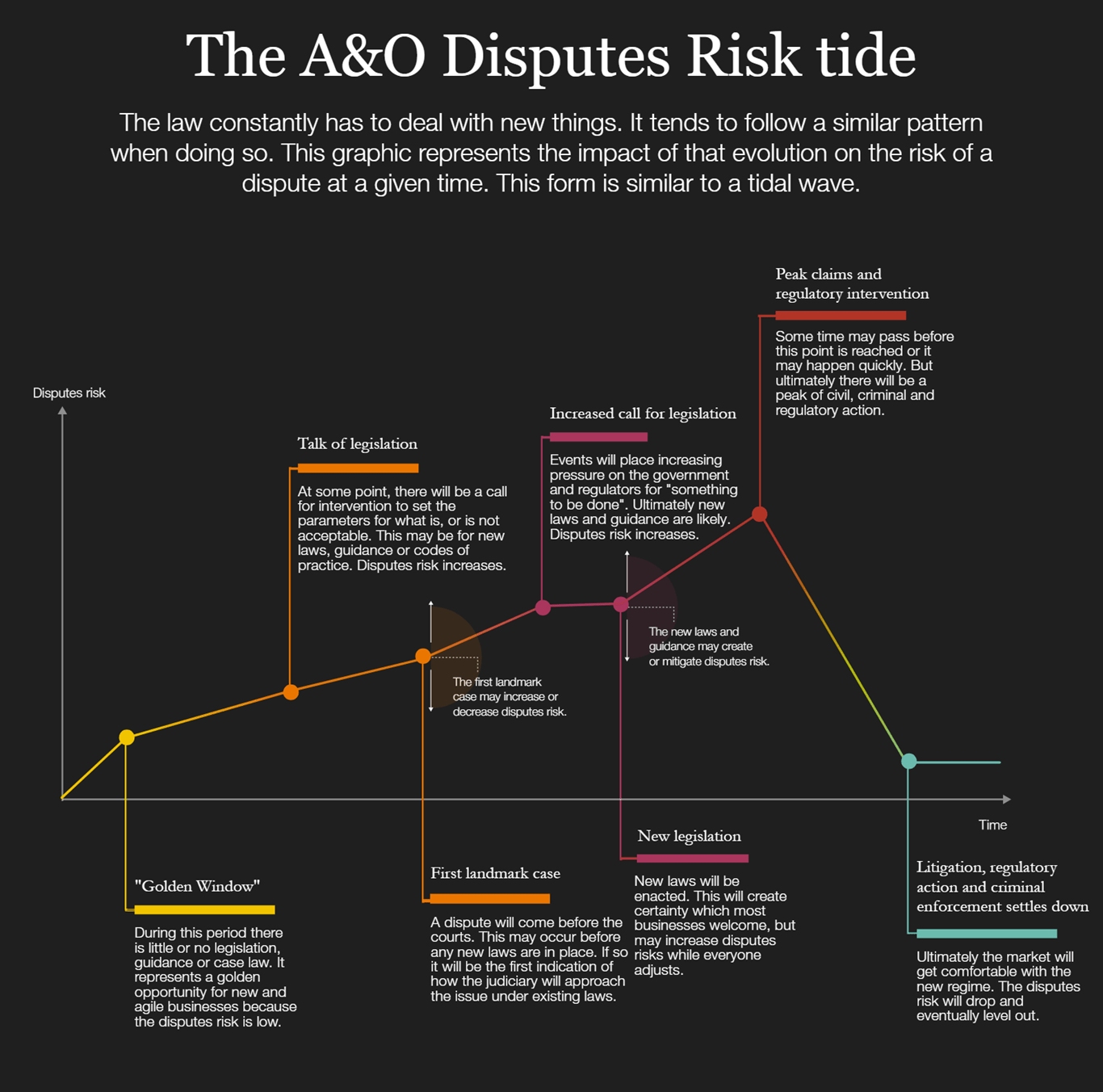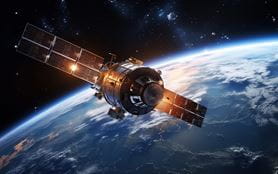Mining and manufacturing in outer space: The new frontier in disputes risks
Related people
Contents
Exploiting natural resources, manufacturing products and growing food in space are now well within the realms of possibility. Identifying, assessing and mitigating disputes risks arising from these activities pose a significant challenge given the relative legal vacuum in which parties will be operating.
Interest in exploring space has had a chequered history since the initial moon landings more than half a century ago. Periods of excitement and activity have invariably given way to periods of relative neglect.
More recently, however, there has been a steady and sustained renewal of interest around the world. Over the past decade, the number of commercial players working in the sector has grown substantially and levels of optimism, innovation and investment are increasing year on year.
This growth, fuelled partly by lower cost barriers, is expected to continue as design processes become more efficient, reusable rockets become the norm and the industry begins to benefit from economies of scale.
Growth at this level in any sector tends to bring with it a new focus on the legal and disputes risks that may arise. Those with the most innovative plans to exploit space and its resources are likely to be at the sharp end of those risks and faces some of the biggest legal uncertainties and the highest likelihood of disputes.
While the legal uncertainties facing the more future-focused commercial players in space are significant, there are steps the sector can take to mitigate those risks. In doing so, they can both learn from and provide lessons for those in other new and developing sectors who may be at a similarly early stage in their own disputes risk tide.
What types of activity are on the horizon in space?
One consequence of increasing investment, reducing costs and significant technological advances is that space-based activities that would previously have been economically non-viable are now potentially worth pursuing. We are on the cusp of being able to exploit and extract value from space in a way that has never been possible in the past.
One of the most important of these future opportunities is large-scale resource extraction. Although current extraction initiatives are focused mainly on scientific experiments, the systems and technologies required to allow full-scale commercial mining in space might well be developed within our lifetimes. The potential benefits are enormous. Mining asteroids and other near-Earth objects for minerals and precious metals that are rare or hard to extract on Earth could be transformative for the sectors that rely on them and for the wider politics of the global resource race. It may also add a new dimension to the debate on decarbonisation, bringing both new opportunities and potential challenges in the drive to achieve net zero.
Opportunities will also arise in the manufacturing sector, where there is scope to turn what are often seen as some of the more challenging features of the environment of space to our advantage. In the right circumstances, zero gravity can facilitate efficiencies in productive processes and in some cases improve product quality. In the case of fibre optics, for example, microgravity appears to mitigate the harmful effects of crystallisation caused by the viscosity of key materials as they exist on Earth. Experiments on fibre optical production are already well underway on the International Space Station (ISS).
Disputes arising from exploiting natural resources
As plans to exploit natural resources in space begin to take shape and grow, so too do the legal and disputes risks. There are three principal areas where disputes may arise:
Ownership and rights to exploit land and natural resources
Resource extraction by private parties inevitably raises the issue of ownership of resources. Even the early treaties governing activity in space were alive to questions of ownership, although at that point none had resource extraction by private parties in mind.
The 1967 Outer Space Treaty (OST) provides that outer space, the Moon and other celestial bodies are not subject to national appropriation by any means. The 1979 Moon Agreement sets out the same principle, alongside undertakings by the participating States to create an international regime on exploiting natural resources “as such exploitation is about to become feasible”, although so far it has only been ratified by a handful of States.
Soft law instruments have attempted to build a consensus. NASA’s 2020 Artemis Accords are a series of non-binding multilateral statements addressing a multitude of space governance issues. In particular, the Accords go further than existing treaties by directly addressing the prospect of resource extraction and space resource utilisation, stating that such activities must comply with the OST but that extraction does not inherently constitute national appropriation.
They also provide for the creation of temporary “safety zones” on celestial bodies, with a view to enabling resource extraction to be carried out without interference by others. At first glance, this appears to be an elegant way of approaching the issue, but it has clear shortcomings. For example, the Accords do not specify how safety zones might be allocated and they are not binding globally. Indeed, leading spacefaring States like Russia and China are non-signatories.
More detailed regulation at a national level exists in some jurisdictions. For example, the United States, Luxembourg, the United Arab Emirates and Japan have enacted laws that recognise the ability of private parties to extract resources from celestial bodies. However, at this stage, the regulations remain at a high level.
If private parties start to engage in commercial extraction activities, we may see competing claims by those parties to the same resources or even arguments that no party has the right to appropriate those resources. Some such claims may arise at an international law level between relevant States under the OST or other treaties (notably the 1971 Convention on International Liability for Damage Caused by Space Objects). Among other things, these treaties include express provisions that seek to allocate international responsibility and international liability between participating States for damage caused by space-based activities. They also include a mechanism for bringing claims. Private parties suffering loss cannot rely directly on this mechanism, however, so may be reliant on States to bring such a claim.
We may also see follow-on statutory claims by States against operators under national laws, for example if a State has incurred international liability as a result of the operator’s actions. Claims are also likely to be pursued directly between private parties, for example under the law of obligations.
As we gradually evolve into a spacefaring civilisation, it would make sense for countries to come together and develop a harmonised regime for co-operation in resource extraction, as envisaged by the Artemis Accords. In light of present-day geopolitical tensions, however, it is by no means clear that this will happen.
Equity of access is also likely to remain an ongoing concern. The difficulties in reaching agreement on achieving equity in Earth-based climate sustainability initiatives indicate that the path to equity in space may also be a rocky one, although there may be scope to build on the foundations laid and lessons learnt in the climate context to achieve consensus more quickly in space.
At a domestic law level, we may see States that have not yet legislated domestically in this area coming under increasing pressure to do so to provide clarity for those seeking to exploit natural resources on a for-profit basis. It is a matter squarely on the agenda in recent meetings of the UN’s Committee on Peaceful Uses of Outer Space (COPUOS), in which countries involved in the working group on space activities have called for the benefits of such activities to be shared fairly with developing and non-space-faring nations. Despite this acknowledgement, however, real progress on detailed frameworks that could be widely agreed remains elusive.
Contractual disputes risks between project participants
The contractual disputes likely to arise in relation to resource extraction in space would be easily recognisable to the current population of Earth, but the longer distances and inherent uncertainties of operating in space and the nascent nature of the processes involved are likely to bring novel challenges in documenting obligations, allocating risk and establishing fault or liability when something goes wrong.
Among other things, the risk that contractual arrangements will fail to cater appropriately for what might go wrong will be higher in such an experimental environment than it is in established sectors. What would happen, for example, if a solar flare inhibited or prevented performance if the contract makes no reference to the possibility of such an event? Would the party failing to perform be in breach? Or would a solar flare be characterised as a force majeure or frustrating event? There may be no wider market expectation or understanding for parties to rely on to fill any contractual gaps, at least in the early days.
Over time, standardised industry clauses (and a body of case law) will no doubt be developed which will help protect actors operating on the frontier, but as in all emerging areas, it will take time for this to happen.
There is a strong parallel here with the shift to net zero. In our recent decarbonisation report, we identified a number of disputes risks faced by those operating at the most technologically novel end of the renewables sector, many of which would apply equally to those looking at resource extraction in space. Those operating in the space sector are likely to face disputes arising from the use of new and untested technology and from the fact that contractors are likely to be less experienced and less well established (and so less able to anticipate or mitigate risks, and more financially vulnerable) than those in more established sectors.
Contractual disputes risks may also arise from the uncertainty of the regulatory landscape (which may well be changing to keep up with developments in the sector, making the baseline for any legal risk assessment and contractual allocation of responsibility and liability unpredictable). In the sustainability context, regulatory change has meant that traditional contractual arrangements and risk allocations have had to be reassessed and redrafted. In space, this type of reassessment will not be straightforward. Contracts are likely to be put in place years before a project goes live, so that parties will be drafting and entering into contractual obligations based on predictions rather than reality.
One way to carry out a more effective reassessment and mitigate the disputes risks in this area will be to seek detailed input from technology and project teams at the contracting stage to help identify the underlying practical risks and enable a more accurate view to be taken as to how they should be quantified and allocated. The key commercial terms of extraction project contracts can then be reviewed and, where necessary, redrafted in light of that input. The same may be true for “crisis clauses” and other supporting provisions, such as termination provisions, change of law clauses and governing law and dispute resolution provisions, all of which will have a role to play in the legal risk mitigation exercise.
Contractual flexibility may need to be built in to allow room for manoeuvre when the unexpected happens. As we have discussed in Legal agility and risk resilience: How to enhance your organisation’s readiness to withstand the next crisis, drafting in a contractual right to mandate changes in roles, levels of service provision or location of activities can reduce exposure to potential disputes, but that must be weighed against the loss of certainty that is inherent in a more flexible contractual arrangement, in particular when the flexibility is afforded to all contracting parties.
Although it may be further over the horizon, if extraction activities in space lead to scarce resources becoming more abundant, this may also affect the pricing of those resources, creating another fertile ground for contractual disputes if the profitability and viability of existing extraction projects on Earth are put at risk as a result. Again, there is a strong parallel here with the contentious issues we are seeing arising in the transition to net zero, with the shift away from carbon having a significant impact on existing interests in the conventional energy sector.
Looking beyond the substantive legal merits, gathering evidence to diagnose problems and assert claims will also give rise to difficulties. Even if solar flares are catered for in a contract, proving to the court or an arbitral tribunal that a solar flare was the cause of failure may be another challenge altogether. These difficulties may well be addressed by the growing industry of space situational awareness services, i.e. companies offering information gathering and monitoring services to assist space operations.
Alleged environmental harm
Where resource extraction in space gives rise to environmental harm, the scope for disputes will potentially be significant, if the harm impacts others.
At an international law level, there are already legal obligations on States to prevent harmful contamination, both in space itself and on Earth (including in both the OST and the Moon Agreement). The growing wave of litigation seeking to attribute liability for climate harms caused by activities on Earth illustrates the types of claim we might see in relation to harmful activities in space that may have detrimental impacts on third parties.
The unique nature of space-based resource extraction may give rise to even more significant challenges in establishing liability than those faced by claimants in the climate context. It may be particularly difficult to establish that they, specifically, have suffered loss if damage is to the environment of space rather than on Earth.
Disputes risks in manufacturing
The idea that space might be a beneficial environment for product development and manufacture is not a new one. Almost 40 years ago, Ronald Reagan described how “[i]n the zero gravity of space, we could manufacture in 30 days lifesaving medicines it would take 30 years to make on Earth. We can make crystals of exceptional purity to produce supercomputers, creating jobs, technologies and medical breakthroughs beyond anything we ever thought possible”.
Experimental product manufacture in space is already taking place regularly on the ISS. Food technology is a particular growth area, both with a view to sustaining long-distance space travel and for use on Earth (for example developing new probiotics that benefit from the unique conditions in space).
Beyond the benefits of low-gravity, space offers the prospect of improved sustainability across a wide range of manufacturing activities, not least because it has the potential to reduce energy demand on Earth. That certainly appears to be the view of Jeff Bezos, who has said: “You shouldn’t be doing heavy manufacturing on Earth. We can build gigantic chip factories in space.”
Intellectual property used in manufacturing processes
Space is an experimental environment. A key consideration for those carrying out manufacturing in space will be whether and how patent protection applies. The territorial nature of intellectual property law means that, without an international framework, it remains to be seen how existing laws will apply to the registration and enforcement of rights in outer space.
The basic principle under Article VIII of the OST is that the State of registration of a launching spacecraft maintains jurisdiction and control of that spacecraft and its personnel while in outer space. Thus the intellectual property laws of the State of registration should arguably apply to the use of inventions on that space object.
This rule informs the legal arrangement agreed by the Partner States of the ISS. That arrangement provides that, for the purposes of intellectual property law, an activity occurring in or on a Space Station flight element (i.e. one of the 16 pressurised modules, which are allocated to each participating nation) will be deemed to have occurred only in the territory of the Partner State of that element’s registry. It further provides that, in relation to inventions on the ISS, the country of inventorship will be determined by the ownership and registry of the element in which the invention has taken place.
Private companies working (and experimenting) on the ISS will also generally have their own contractual framework with the national space agency that has given them access to the ISS. The European Space Agency (ESA) explains, for example, that “the ownership and the exploitation of any intellectual property - data or product - resulting from the Space Station utilisation will then be highly dependent on the type of contract the users will have signed with ESA”.
While the existing arrangements provide some basis for a future legal framework, it is by no means comprehensive (and much appears to be governed by ad hoc agreements). As experimentation moves beyond the confines of the ISS and potentially to other planets or private space stations, questions remain about how IP regulation and enforcement in outer space will evolve.
The U.S., for example, has already legislated on how patent protection applies to inventions made, used or sold in outer space – but it is unclear whether other States will adopt consistent approaches.1 For some matters, the extension of national law is unlikely to be suitable. There are currently no rules, for example, on how intellectual property rights apply to inventions made or used on the Moon.
Aside from the (non-) existence of a legal framework, there are more practical questions about how private parties can monitor and enforce intellectual property rights, particularly for products that may never return to Earth. This leaves open significant gaps for the international community (both public and private) to fill.
Supply-chain disputes relating to manufacturing in space
From a supply-chain perspective, manufacturing in space will create new challenges. The manufacturing supply chain will become both longer and more complex. The risks of delay and/or failure in transport systems will be significantly heightened compared with manufacturing on Earth. So too will the risks of failures in the manufacturing process itself: as with all new processes, the scope for things to go wrong is greater in the earlier stages of development than when those processes have become established. As a result, disputes risks will increase.
The contractual disputes risks for those in the manufacturing supply chain will mirror many of the contractual risks discussed above in relation to resource extraction. The potential difficulties in diagnosing and evidencing claims apply equally here too.
Unsafe products manufactured in space
As is always the case in the manufacturing context, one potential source of disputes risk is around product safety. Products developed and manufactured in space may require regulation in several respects:
- industry guidelines may be needed to reflect the unique (and potentially unknown) risks of manufacturing products in space
- rules may be required on how such products should be labelled
- rules may be needed on how customers and consumers can enforce their rights in relation to any harm caused by those products
The type of regulations required will be similar across many industries to address the challenge of extrapolating national laws to outer space. On one view, the simple answer is that goods produced in space and sold in a particular market on Earth will be subject to that market’s legislation on product labelling and liability. But there are no easily identifiable answers to these questions when applied to markets off-Earth.
Even within the more immediate scenario of products supplied to Earth, space raises challenges that are not envisaged in the current system. For instance, the risks posed by developing products in space may not yet be known, and may not be foreseeable to those producing them. It may potentially be unreasonable to impose liability in some cases.
Similarly, enforcement may cause difficulties in circumstances where producers only have assets in outer space (and thus potentially outside the jurisdiction of any given State), or in circumstances where companies operating in outer space attempt to exclude product liability in their terms and conditions. This latter risk will also involve questions around identifying the appropriate governing law and/or forum for claims that may be based on tort.
In the absence of international agreement, it may be that these issues are best addressed in national licensing regimes applicable to space manufacturing – but any comprehensive understanding or consensus of how those conditions would be drafted does not appear to be likely in the short term.
Implications for disputes risks at the outer edges of the space race
The lack of a clear legislative framework regulating resource extraction, manufacturing or indeed many other nascent activities in space is hardly surprising given that large-scale operations of this type have not yet got off the ground. But it is very easy to see that a scale-up in activities on other celestial bodies will inevitably mean more disputes and increasing calls for legislative infrastructure to support and regulate those activities.
Even the most adventurous space explorers would probably recognise that a complete legal vacuum will ultimately inhibit investment, even in the vacuum of space. As UK astronaut Tim Peake acknowledged in an interview with the Financial Times, the lack of rules for governing space is ultimately problematic: “We need a new set of regulations that recognises the commercial era that we’re into…We need to work much harder.”

That is certainly a pattern we have seen – and are likely to see in the future – in other developing sectors. For those who see opportunity in an absence of legal regulation (and there are many who do), the takeaway is to act quickly, because the window of opportunity may not last.
Here, as in other sectors, as the window starts to close, engagement by market participants with governments, regulators and other stakeholders will be critical to ensuring that the legal frameworks, regulatory regimes and behavioural norms that become established in space are proportionate, balanced and fair. Those who look over the horizon to monitor, engage with and respond to proposed legislative change in this way will find themselves best placed to manage both the opportunities and risks that legal change may bring.
Focusing on future-proofing contractual arrangements will also be key, both for the new players and for those in established industries that may be at risk of disruption. In instances where growth and development trajectories are uncertain, this may be easier said than done.
More activity and increasing levels of regulation may, in the short term, drive more disputes. This is particularly likely to be the case if regulations and guidance continue to be developed on a piecemeal and fragmented basis at industry body or national law level rather than internationally, for example via multilateral treaties.
Nevertheless, as the sector matures over time, key players will develop more sophisticated and agile compliance functions and the risk of being embroiled in disputes will likely fall as a result. Maintaining close relationships with regulators, policymakers, stakeholders and industry bodies and ensuring that engagement is on point, timely and accurate, will be key to managing ongoing compliance risks.
Footnotes
- The Patents in Space Act of 1990 (35 U.S.C. § 105).














